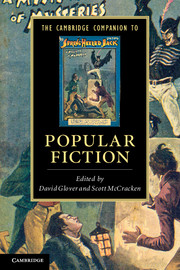Book contents
- Frontmatter
- Introduction
- 1 Publishing, history, genre
- 2 Fiction, theatre and early cinema
- 3 Television and serial fictions
- 4 The public sphere, popular culture and the true meaning of the zombie apocalypse
- 5 The reader of popular fiction
- 6 Reading time: popular fiction and the everyday
- 7 Gender and sexuality in popular fiction
- 8 Pulp sensations
- 9 Bestselling fiction: machinery, economy, excess
- 10 Comic books and graphic novels
- 11 Popular fiction in the digital age
- Further reading
- Index
- Cambridge Companions to …
8 - Pulp sensations
Published online by Cambridge University Press: 28 May 2012
- Frontmatter
- Introduction
- 1 Publishing, history, genre
- 2 Fiction, theatre and early cinema
- 3 Television and serial fictions
- 4 The public sphere, popular culture and the true meaning of the zombie apocalypse
- 5 The reader of popular fiction
- 6 Reading time: popular fiction and the everyday
- 7 Gender and sexuality in popular fiction
- 8 Pulp sensations
- 9 Bestselling fiction: machinery, economy, excess
- 10 Comic books and graphic novels
- 11 Popular fiction in the digital age
- Further reading
- Index
- Cambridge Companions to …
Summary
A 1933 article entitled ‘The Pulps: Day Dreams for the Masses’ introduced Vanity Fair's upscale readers to the vast literary underworld of pulp magazines. The exposé called writers of pulp fiction ‘hacks’, implied their readers were only marginally literate, and characterised the magazines themselves as ‘gaudy, blatant, banal’, representing ‘the incursion of the Machine Age into the art of tale-telling’. These were all familiar charges. Pulp fiction was an often sensational, mass-produced literature that had appeared in the pages of pulp magazines and cheap paperbacks in the late nineteenth and early twentieth centuries. The name, ‘pulp fiction’, comes from the cheap, wood-pulp paper on which these stories were printed. Descendants of nineteenth-century dime novels, pulp magazines and paperback originals were frequently viewed as ‘trash’ – cheap, disposable and lacking in literary quality. Rather than evoking a reader's refined, higher feelings, these stories were charged with appealing to baser, corporeal emotions. These reputed moral and aesthetic failings aside, however, pulp fiction has warranted increasing interest in the last twenty years from scholars who see it as an avenue for investigating popular worldviews and for tracking the complex encounter between ordinary people and commercial culture.
- Type
- Chapter
- Information
- The Cambridge Companion to Popular Fiction , pp. 141 - 158Publisher: Cambridge University PressPrint publication year: 2012
- 8
- Cited by

